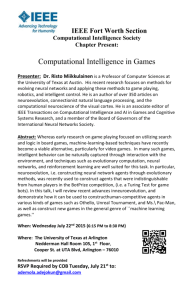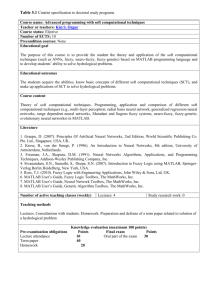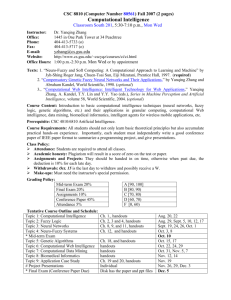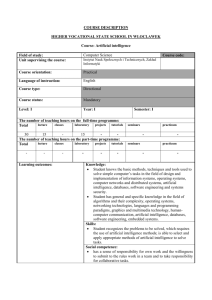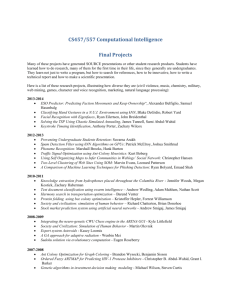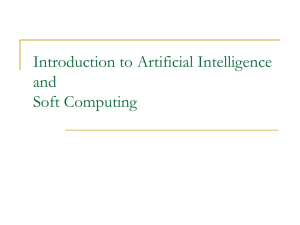ci-sylab
advertisement
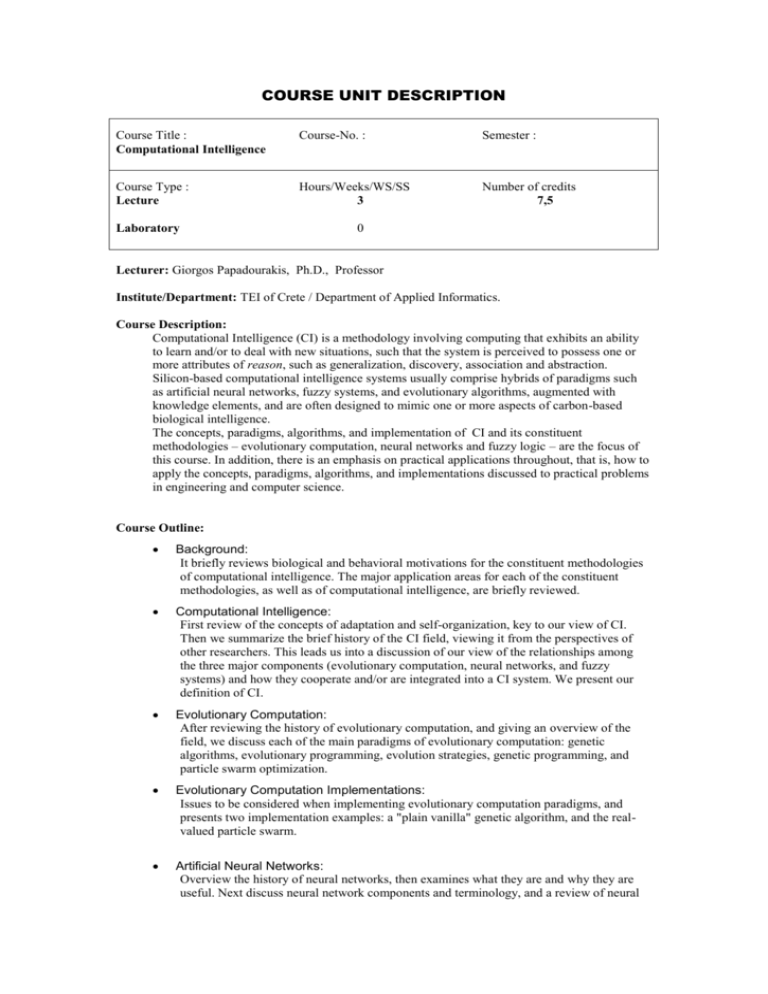
COURSE UNIT DESCRIPTION Course Title : Computational Intelligence Course-No. : Semester : Course Type : Lecture Hours/Weeks/WS/SS 3 Number of credits 7,5 Laboratory 0 Lecturer: Giorgos Papadourakis, Ph.D., Professor Institute/Department: TEI of Crete / Department of Applied Informatics. Course Description: Computational Intelligence (CI) is a methodology involving computing that exhibits an ability to learn and/or to deal with new situations, such that the system is perceived to possess one or more attributes of reason, such as generalization, discovery, association and abstraction. Silicon-based computational intelligence systems usually comprise hybrids of paradigms such as artificial neural networks, fuzzy systems, and evolutionary algorithms, augmented with knowledge elements, and are often designed to mimic one or more aspects of carbon-based biological intelligence. The concepts, paradigms, algorithms, and implementation of CI and its constituent methodologies – evolutionary computation, neural networks and fuzzy logic – are the focus of this course. In addition, there is an emphasis on practical applications throughout, that is, how to apply the concepts, paradigms, algorithms, and implementations discussed to practical problems in engineering and computer science. Course Outline: Background: It briefly reviews biological and behavioral motivations for the constituent methodologies of computational intelligence. The major application areas for each of the constituent methodologies, as well as of computational intelligence, are briefly reviewed. Computational Intelligence: First review of the concepts of adaptation and self-organization, key to our view of CI. Then we summarize the brief history of the CI field, viewing it from the perspectives of other researchers. This leads us into a discussion of our view of the relationships among the three major components (evolutionary computation, neural networks, and fuzzy systems) and how they cooperate and/or are integrated into a CI system. We present our definition of CI. Evolutionary Computation: After reviewing the history of evolutionary computation, and giving an overview of the field, we discuss each of the main paradigms of evolutionary computation: genetic algorithms, evolutionary programming, evolution strategies, genetic programming, and particle swarm optimization. Evolutionary Computation Implementations: Issues to be considered when implementing evolutionary computation paradigms, and presents two implementation examples: a "plain vanilla" genetic algorithm, and the realvalued particle swarm. Artificial Neural Networks: Overview the history of neural networks, then examines what they are and why they are useful. Next discuss neural network components and terminology, and a review of neural network topologies. A more detailed look at neural network learning and recall follows, focusing on three of the most commonly used neural network paradigms: backpropagation, learning vector quantization, and self-organizing feature map networks. Hybrid networks and recurrent networks are briefly discussed. Finally, the issues of pre-processing and postprocessing are examined. Neural Network Implementations: Discuss issues to be considered when implementing artificial neural networks, and presents four implementation examples: backpropagation, learning vector quantization, selforganizing feature maps, and evolutionary neural networks. Fuzzy Systems: Brief review of the history of the field, followed by an examination of fuzzy sets and fuzzy logic, the concepts of fuzzy sets, and approximate reasoning. The differences between fuzzy logic and probability are stressed. Both Mamdani and Takagi-Sugeno approaches to the design and analysis of fuzzy systems are presented. Conclude by looking at some issues and special topics related to fuzzy systems. Fuzzy System Implementations: Discusse issues to be considered when implementing fuzzy systems, and presents two implementation examples: a traditional fuzzy rule system, and an evolutionary fuzzy system. Computational Intelligence Implementations: Reflect recent developments in the field, including evolutionary fuzzy systems and approaches to system adaptation using computational intelligence. The interaction and cooperation among the three basic components of computational intelligence will be expanded and a section on adaptive evolutionary computation using fuzzy systems and/or neural networks will be included. The role of non-linear dynamics (chaos theory) in computational intelligence is emphasized. Included will be material on recent developments in "edge of chaos" research and development that focuses on complex systems. Textbook: Eberhart, E. and Y. Shi., Computational Intelligence: Concepts and Implementations, Morgan Kaufmann, San Diego, 2007. References: 1. 2. 3. 4. 5. 6. Engelbrecht, A.P., Computational Intelligence: An Introduction, John Wiley, New York, 2003. Konar, A., Computational Intelligence: Principles, Techniques, and Applications, Springer, Berlin, Germany, 2005. Kantardzic, M., Data Mining: Concepts Models, and Algorithms, IEEE Press and John Wiley, New York, 2003. Negnevitsky, M., Artificial Intelligence: A Guide to Intelligent Systems, Addison Wesley, 2002. Fogel, D.B. and C.J. Robinson (Eds), Computational Intelligence: The Experts Speak, John Wiley, New York, 2003. Cios, K., W. Pedrycz, and Swiniarski, R., Data Mining: Methods for Knowledge Discovery, Kluwer 1998. Teaching method: Lectures, supported by transparencies using PowerPoint. Assessment: Assignments: 3 (every 3 weeks) Project work: 3 Final 15% 45% 40%
